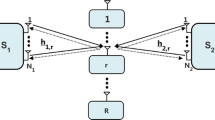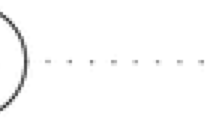Abstract
The outage probability performance of network coding for multicast relay system is analyzed in Nakagami-m fading channels. Two transmission strategies, i.e., complex field network coding (CFNC) and amplify-and-forward network coding (AFNC), are applied in the system, and the approximate expressions of outage probability are derived at high SNR and the conclusion is reached that the system diversity gains of two transmission strategies are both 2m, as is verified by numerical simulations. Simulation results also show that CFNC can outperform both AFNC and direct transmission without relay in the performances of system outage probability, sum rate and symbol error ratio.
Similar content being viewed by others
References
Ahlswede R, Cai N, Li S R, et al. Network information flow. IEEE Trans Inf Theory, 2000, 46: 1204–1217
Katti S, Gollakota S, Katabi D. Embracing wireless interference: Analog network coding. Technical Report, Computer Science and Artificial Intelligence Laboratory, MIT-CSAIL-TR-2007-012, 2007
Katti S, Rahul H, Hu W, et al. Xors in the air: Practical wireless network coding. In: Proc ACM SIGCOMM, Pisa, Italy, 2006. 243–254
Ding Z, Leung K K, Goeckel D L, et al. On the study of network coding with diversity. IEEE Trans Wirel Commun, 2009, 8: 1247–1259
Zhao R, Yang L, Zhu W. Transmission scheme and performance analysis for decode-and-forward MIMO two-way relay systems. Sci China Ser F-Inf Sci, 2009, 52: 2308–2316
Chen Y, Kishore S, Li J. Wireless diversity through network coding. In: Proceeding of IEEE Wireless Communications and Networking Conference (WCNC), Las Vegas, USA, 2006. 1681–1686
Maric I, Goldsmith A, Medard M. Information-theoretic relaying for multicast in wireless networks. In: Proc Military Communications Conference (MILCOM), Orlando, USA, 2007. 1–7
Zhang S, Liew S C, Lam P P. Physical-layer network coding. In: Proc IEEE MobiComm, Los Angeles USA, 2006. 358–365
Wang T, Giannakis G. Complex field network coding for multiuser cooperative communications. IEEE J Select Areas Commun, 2008, 26: 561–571
Riemensberger M, Sagduyu Y E, Honig M L, et al. Comparison of analog and digital relay methods with network coding for wireless multicast. In: Proc of the IEEE International Conf on Commun (ICC), Dresden, Germany, 2009. 1–5
Ding Z, Ma Z, Leung K K. Impact of network coding on system delay for multi-source multi-destination scenarios. IEEE Trans Veh Tech, 2010, 59: 831–841
Li J, Chen W. Power allocation in the high SNR regime for a multicast cell with regenerative network coding. IEEE Commun Lett, 2009, 13: 271–273
Tse D, Viswanath P. Fundamentals of Wireless Communication. New York: Cambridge University Press, 2005
Ding Z, Ratnarajah T, Cowan C C F. On the diversity-multiplexing tradeoff for wireless cooperative multiple access systems. IEEE Trans Signal Process, 2007, 55: 4627–4638
Tse D, Viswanath P, Zheng L. Diversity-multiplexing tradeoff in multiple-access channels. IEEE Trans Inf Theory, 2004, 50: 1859–1874
Simon M K, Alouini M S. Digital Communications over Fading Channels: A Unified Approach to Performance Analysis. New York: John Wiley and Sons, 2000
Papoulis A. Probability, Random Variables, and Stochastic Processes. 3rd ed. New York: McGraw-Hill, 1991
Gradshteyn I S, Ryzhik I M. Table of Integrals, Series and Products. 7th ed. California: Academic Press, 2007
Abramowitz M, Stegun I A. Handbook of Mathematical Functions With Formulas, Graphs, and Mathematical Tables, 9th ed. New York: Dover, 1970
Shin H, Song J B. MRC analysis of cooperative diversity with fixed-gain relays in Nakagami-m fading channels. IEEE Trans Wirel Commun, 2008, 7: 2069–2074
Azarian K, Gamal H, Schniter P. On the achievable diversity multiplexing tradeoff in half-duplex cooperative channels. IEEE Trans Inf Theory, 2005, 51: 4152–4172
Zhao L, Mo W, Ma Y, et al. Diversity and multiplexing tradeoff in general fading channels. IEEE Trans Inf Theory, 2007, 53: 1549–1557
Tse D, Viswanath P, Zheng L. Diversity-multiplexing tradeoff in multiple-access channels. IEEE Trans Inf Theory, 2004, 5: 1859–1874
Author information
Authors and Affiliations
Corresponding author
Rights and permissions
About this article
Cite this article
Zhao, R., Yang, L. & Huang, Y. Performance analysis of network coding for multicast relay system over Nakagami-m fading channels. Sci. China Inf. Sci. 54, 2338–2348 (2011). https://doi.org/10.1007/s11432-011-4419-0
Received:
Accepted:
Published:
Issue Date:
DOI: https://doi.org/10.1007/s11432-011-4419-0




